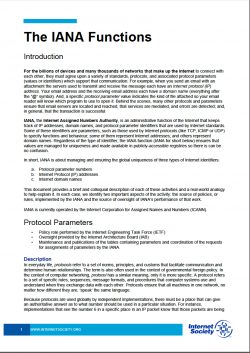For the billions of devices and many thousands of networks that make up the Internet to connect with each other, they must agree upon a variety of standards, protocols, and associated protocol parameters (values or identifiers) which support that communication. For example, when you send an email with an attachment the servers used to transmit and receive the message each have an Internet protocol (IP) address. Your email address and the receiving email address each have a domain name (everything after the “@” symbol). And, a specific protocol parameter value indicates the kind of file attached so your email reader will know which program to use to open it. Behind the scenes, many other protocols and parameters ensure that email servers are located and reached, that services are mediated, and errors are detected; and, in general, that the transaction is successful.
IANA, the Internet Assigned Numbers Authority, is an administrative function of the Internet that keeps track of IP addresses, domain names, and protocol parameter identifiers that are used by Internet standards. Some of these identifiers are parameters, such as those used by Internet protocols (like TCP, ICMP or UDP) to specify functions and behaviour; some of them represent Internet addresses; and others represent domain names. Regardless of the type of identifier, the IANA function (IANA for short below) ensures that values are managed for uniqueness and made available in publicly-accessible registries so there can be no confusion.
In short, IANA is about managing and ensuring the global uniqueness of three types of Internet identifiers:
a. Protocol parameters
b. Internet Protocol (IP) addresses
c. Internet domain names
This document provides a brief and colloquial description of each of these activities and a real-world analogy to help explain it. In each case, we identify two important aspects of the activity: the source of policies, or rules, implemented by the IANA and the source of oversight of IANA’s performance of that work.
